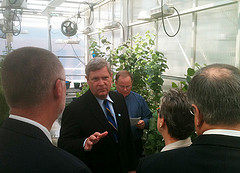
UNIVERSITY PARK – Investment in agricultural research doesn’t benefit just the 2 percent of the population involved in farming. It’s a matter of national security, job creation, energy independence and human health.
That’s according to U.S. Agriculture Secretary Tom Vilsack, who visited Penn State’s University Park campus this week (May 16) to tour College of Agricultural Sciences research facilities and commemorate this year’s 150th anniversaries of the U.S. Department of Agriculture and the Morrill Act of 1862, which created America’s land-grant university system.
Vilsack spoke to a capacity crowd of more than 200 in the Life Sciences Building’s Berg Auditorium, where he acknowledged current economic challenges while citing a need for continued research funding.
“We will be a government that spends less money, but one that must increase investment in education and research,” he said. “Why? Because that is the vehicle through which this country gets back into the business that it’s always been great at: innovating and creating.”
Vilsack cited statistics showing that every $1 invested in ag research brings a $20 return. “As a result of agricultural research, since 1980 agriculture has been the second most productive aspect of our economy,” he said. “The research that’s been done over the last 30 years is nothing short of remarkable. It’s happening here, and it’s a result of partnerships between Penn State and government entities like USDA.”
Bruce McPheron, dean of the College of Agricultural Sciences, said maintaining that university research enterprise and the extension system that translates the science for use in the field is becoming increasingly difficult due to the erosion in public funding in recent years. “When state and federal appropriations are cut or remain flat — and costs continue to rise — we lose capacity to address these critical issues and support a vibrant food and fiber sector.”
After visiting a greenhouse where biofuels research is taking place, Vilsack touted plant-genetics work aimed at finding ways to break down cellulose so that plant sugars can be extracted for fuel. He credited biofuels with helping to reduce U.S. oil imports from 62 percent to 45 percent in the last three years.
Vilsack noted that scientists also are developing methods for turning plant and livestock waste into useful and valuable materials — such as chemicals, polymers and fibers — and in turn reducing reliance on petroleum-based products. “The bio-based economy is beginning to take hold, which falls right into the vision of a country that creates and innovates,” he said. “And research is at the center of this.”
Research also is the most important component of maintaining food safety, Vilsack contended, because of pathogens’ ability to evolve quickly and get ahead of the science. He cited new research-based standards in beef and poultry production that could reduce foodborne illnesses due to E. coli, Salmonella and campylobacter by 25,000 cases a year, likely saving hundreds of lives.
“You’re doing research here that will allow us to better understand (pathogens),” he said, referring to his earlier tour of labs and pilot plants in Penn State’s Food Science Building. “You’re doing research that will ensure that the HACCP [Hazard Analysis of Critical Control Points] plans we put together in processing facilities are what they need to be to stay ahead of the pathogens.”
Food scientists also have a role to play in improving nutrition and addressing obesity and related health care issues, such as diabetes. But the challenge, Vilsack explained, is to make healthy choices more palatable for consumers.
“How are you going to reformulate the food so you can reduce the sodium, sugar and fat, and still make it the choice?” he said. “You’re doing research here at Penn State that’s going to allow us to understand all the complexities of food choices, from how our brains work to genetics to the taste of food.”
Vilsack emphasized that the United States is a food-secure nation, but warned the audience not to take that for granted. He said 85 percent of the food consumed in the United States is grown here, and what is imported is merely for convenience. “We like to have avocados 12 months out of the year instead of six months out of the year,” he said.
“We start with a national security advantage because we have the capacity to feed ourselves. That’s directly related to the science that has led to this productivity.”
Many countries are not so fortunate. And in light of rising world population and increasing demand for food, USDA has launched its Feed the Future initiative. Land-grant universities have an important role to play, according to Vilsack.
“We’ll have to increase agricultural production by 70 percent globally in the next 40 years just to meet the needs of the rising human population,” he said. “That’s going to require research and technology transfer in countries and locations that may not have the sophisticated universities like the one we’re at today.”
In the end, Vilsack told the audience, agricultural research is about maintaining and enhancing a way of life. “So when you go back to those labs, back to the farm, back to your office, back to school, understand what’s at stake here,” he said. “It’s not just a research project, it’s not just getting money for the university, it’s not just the whiz-bang science and the excitement of discovery.
“It’s about saving lives, creating jobs, improving incomes, feeding hungry people, making a nation secure, making the world a better place, preserving the planet and preserving a value system. That’s why research is important.”
Secretary Vilsack’s entire speech can be viewed online.
Chuck Gill, Penn State University